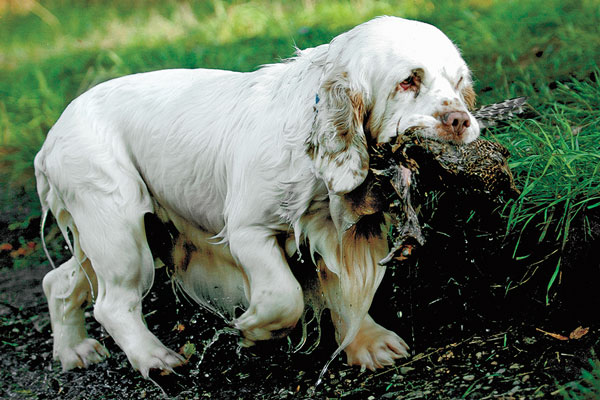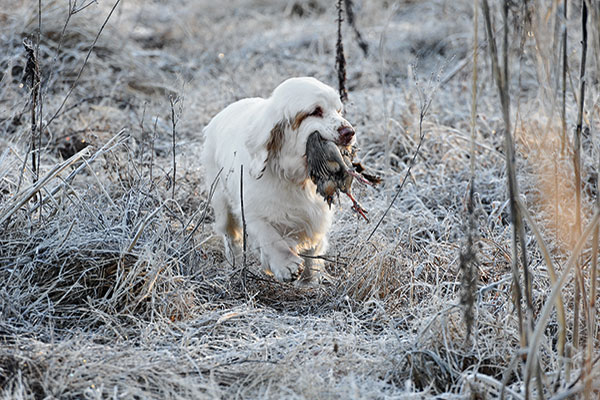 Back in the days when I judged spaniel hunt tests, on those rare occasions when the dog running was a Clumber spaniel it always seemed like I should've been wearing a tweed jacket and tie instead of faded jeans and a T-shirt. The presence and hunting style of this breed makes me think of a dog you would expect to see snuffling out birds for a pair of sedate, older English gentlemen carrying side-by-side Purdeys.
Back in the days when I judged spaniel hunt tests, on those rare occasions when the dog running was a Clumber spaniel it always seemed like I should've been wearing a tweed jacket and tie instead of faded jeans and a T-shirt. The presence and hunting style of this breed makes me think of a dog you would expect to see snuffling out birds for a pair of sedate, older English gentlemen carrying side-by-side Purdeys.
I once judged a Clumber that clearly had ambitions to outrun a saluki and whose manner in the field could best be described as "my feet are like wings"; this particular dog was an exception to the usual Clumber "rule." Virtually all the other Clumbers I've seen worked methodically, using superb ability to find birds to good advantage.
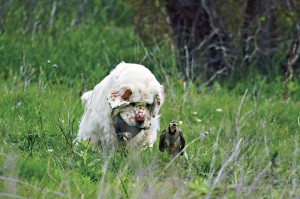 "Methodical" in this case does not necessarily equate to "slow." Many moved quite quickly but almost always well within gun range, and they were absolute vacuums when it came to sweeping a field for birds. In other words, they are exactly what many hunters with arthritic joints need in a hunting dog.
"Methodical" in this case does not necessarily equate to "slow." Many moved quite quickly but almost always well within gun range, and they were absolute vacuums when it came to sweeping a field for birds. In other words, they are exactly what many hunters with arthritic joints need in a hunting dog.
Not that it's a requirement to be well on the way to old fogeydom before you get a Clumber, as lots of young and athletic hunters also like the breed's style. But for those whose hips, knees and ankles are starting to remind them they are no longer callow youths, a Clumber can be the perfect gun dog.
"Perhaps the main reason why this is so is simply because there are so few Clumbers available," said Roe Froman, DVM, as to why there are not more of the breed afield. "Despite the fact that Clumbers were one of the first 10 breeds recognized by the AKC, there are usually less than 200 puppies available nationwide every year. So besides being a well-kept secret, once someone learns about the breed and decides that this is the kind of dog they want to hunt with, it takes diligence and a great deal of patience to actually get one.
"But it's worth the wait due to their determination and exquisite sense of smell. They have amazing noses, often putting up birds after other spaniels have passed them. They may not be speed demons but can be a lot faster than many people think! I've always loved it when guys who are unfamiliar with Clumbers cripple a bird. Their response is always the same: Their jaws drop, they roll their eyes and they say 'Damn, I didn't know that dog could MOVE that fast!'"
"I've always taken exception to those who try to classify Clumbers as a 'gentleman's hunting dog' when what they are really saying is that Clumbers are slow and suitable for older hunters," said Kirk Zucal. "Yes, they are suitable for older hunters but they are also suitable for young, athletic hunters as well.
"Clumbers in the field move at a good clip with animated purpose. You can see just how happy they are by how they move. They gravitate to obvious game-holding areas and give lesser cover just a cursory sniff. Instead of the perfect quartering pattern expected of other flushing breeds, Clumbers give you a somewhat aggressive and incredibly diligent and thorough investigation of game-holding cover."
Clumber Lines
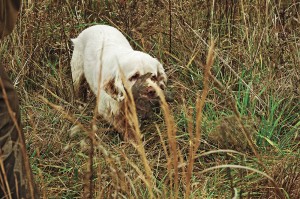 This is a very old breed and as is the case with most ancient lineages, figuring out whence cometh the Clumber spaniel is mainly a case of guesswork. The distinctive head of the Clumber, as well as its lemon and white colors, may come from the early Alpine spaniel. But this is mainly supposition as there is nothing in the way of definitive evidence to support this theory.
This is a very old breed and as is the case with most ancient lineages, figuring out whence cometh the Clumber spaniel is mainly a case of guesswork. The distinctive head of the Clumber, as well as its lemon and white colors, may come from the early Alpine spaniel. But this is mainly supposition as there is nothing in the way of definitive evidence to support this theory.
Another theory says the breed was developed by crossing large spaniels with St. Hubert's hounds or bassets, but there is only some circumstantial evidence to support this. What is known is that the Clumber was one of the earliest spaniels developed for special work. The breed's actual origin will probably never be accurately determined as the Clumber differs so greatly from the rest of the spaniels.
There is little doubt how the breed came to be called the Clumber spaniel, however. The name stems from the breed's association with the Duke of Newcastle's estate at Clumber Park, where the Duke's gamekeeper, William Mansell, has been credited with developing and improving the breed.
Although the Duke tried to keep the breed to himself, he eliminated that possibility by giving Clumber pups as gifts to friends and the popularity of the breed began to spread. Clumbers were first imported to North America by an officer in a British regiment that was stationed in Nova Scotia.
According to Clumber people, this breed has several characteristics that cause it to stand out among hunting spaniels. "For one thing, they're pure white which makes them highly visible in thick underbrush," said Carol Reeves, the field chair for the Clumber Spaniel Club of America. "They have what's known as a 'hesitation flush' where, if the bird doesn't make a lively break from cover, a Clumber will slow down and stalk the bird almost like a cat stalks birds.
"When they actually locate the bird, most Clumbers will stop before they pounce, giving you time to prepare for the shot. Then, when they do pounce, they will try to bat the bird down with their paw and retrieve it without bruising the meat.
"This is something of a throwback to the original breed type when shotguns were not all that accurate and the dogs worked in a line through the brambles. While their style may appear to be nonchalant, their nose is so superior they don't need to cover the entire field. In fact, at hunt tests, we love to follow other breeds as they pass birds because of their speed and strict quartering pattern."
Nose On, Ears off
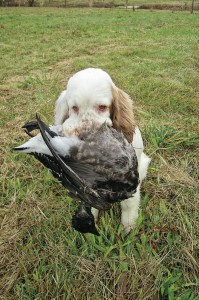 Some of the breed's characteristics can create problems for inexperienced owners and trainers, however. "They can be stubborn when it comes to training," said Michael Finnegan. "But we've found that with reasonable training, they can excel at just about anything. Because the breed is so scent-driven, they do have a tendency to turn their ears off when their nose turns on and this can be a struggle for inexperienced owners and trainers.
Some of the breed's characteristics can create problems for inexperienced owners and trainers, however. "They can be stubborn when it comes to training," said Michael Finnegan. "But we've found that with reasonable training, they can excel at just about anything. Because the breed is so scent-driven, they do have a tendency to turn their ears off when their nose turns on and this can be a struggle for inexperienced owners and trainers.
"It is also important to emphasize a good delivery on the retrieve as Clumbers can be reluctant to part with their 'treasures.' They work with the greatest enthusiasm with live scent in their noses so whenever possible, we use live birds or fresh scent—feathers, bottled scent—in training to ensure a continued enthusiastic response."
They also need a "light hand" in training, according to D. Shepard Thomas, MD. "It's not a good idea to use an electronic collar with a Clumber as they can shut down. They really shouldn't be punished as they respond well to positive reinforcement and that's the only way they should be trained. It's important to not mistake their determined nature for stubbornness.
"Clumbers are convinced they know more than you do, particularly with regard to where the birds are. You have to learn to respect this and use training techniques to show the dog that maybe you know where birds are that the dog doesn't know about."
Dr. Froman agreed. "Clumbers do not take well to force training," she said. "They get offended. Tillie (Ch. BlueMoon's Heart and Soul CD SH TD WDX), one of our first Clumbers, initially always returned directly to me on a retrieve but wanted to stand against my legs to deliver the bird. When we tried to make her sit in front to deliver, she completely stopped retrieving for a few weeks. When I gave in and let her stand against my legs, she went on to earn her senior hunter title.
"Clumbers also don't like drilling. They are very intelligent dogs with a wicked sense of humor. They will work joyfully for people they love and who treat them as a real partner. You have to keep training interesting for them and then they will give you everything they have."
Adds Kirk Zucal: "One other thing to keep in mind, Clumbers are not a hard-headed breed but they will test you and seemingly question you." I find this hard to explain since they are very eager to please and crave field work. Patience is vitally important with this breed.
While this is a rare breed, if you are persistent and looking in the right places it is not impossible to find one. "If you want a Clumber for your hunting dog, you should get in touch with people who hunt with Clumbers already," said Roe Froman. "AKC hunt tests can be a good place to meet owners and breeders who hunt with the breed.
"The club also has a field chair, Carol Reeves, and a breeder referral person who are familiar with breeders who also hunt their dogs. One really positive aspect of this breed is that there is no split between 'show' and 'field' types. I think all the master hunter titled dogs in the breed and the vast majority of the senior hunters are also finished conformation champions and many of them have placements in the sporting group as well as awards of merit at the national specialty.
"Our dogs literally go from hunt tests to the conformation ring and sometimes also to obedience and tracking, occasionally on the same weekend. As a consequence, it is not hard to find a Clumber that is both a proper representative of the breed and also a fine hunting companion."
"Clumbers are an absolute joy whether in the field, the backyard or on the couch," said Zucal. "I've had a lot of different sporting breeds over the years but I never had a breed that made me laugh more than a Clumber. They simply brighten my day, every day."
